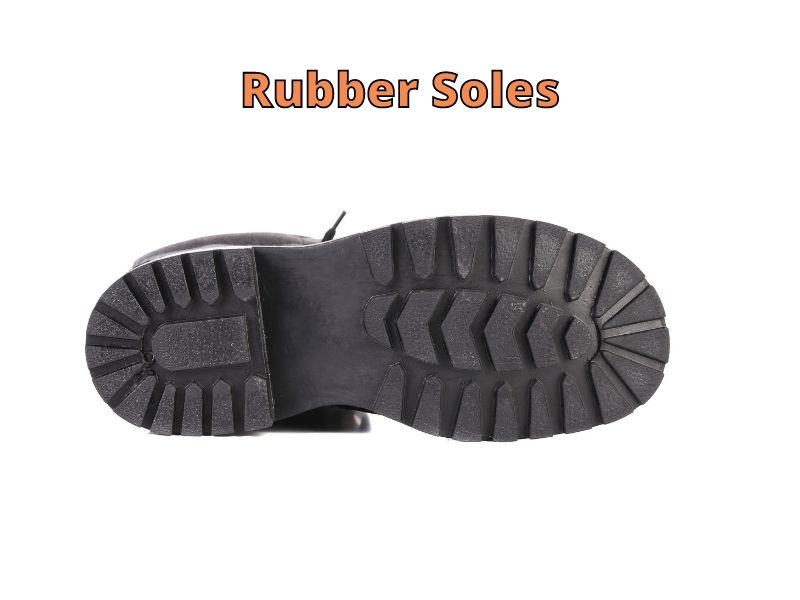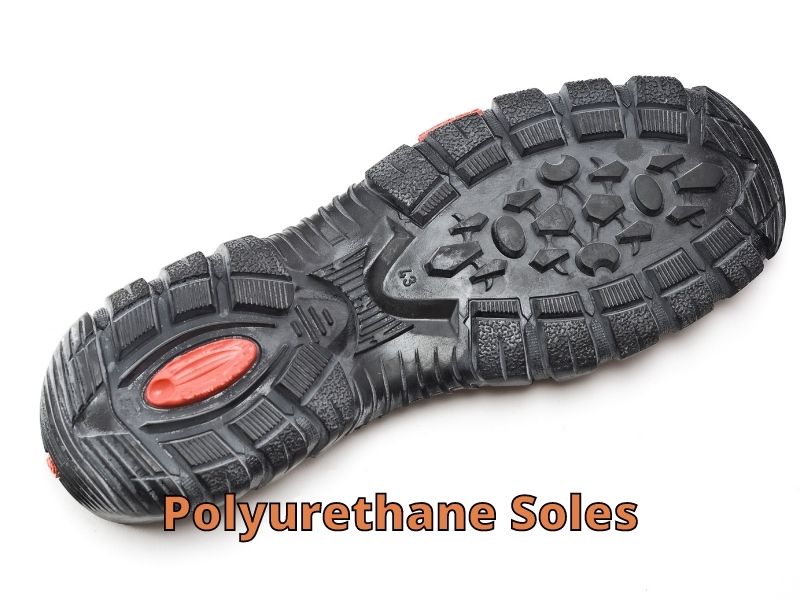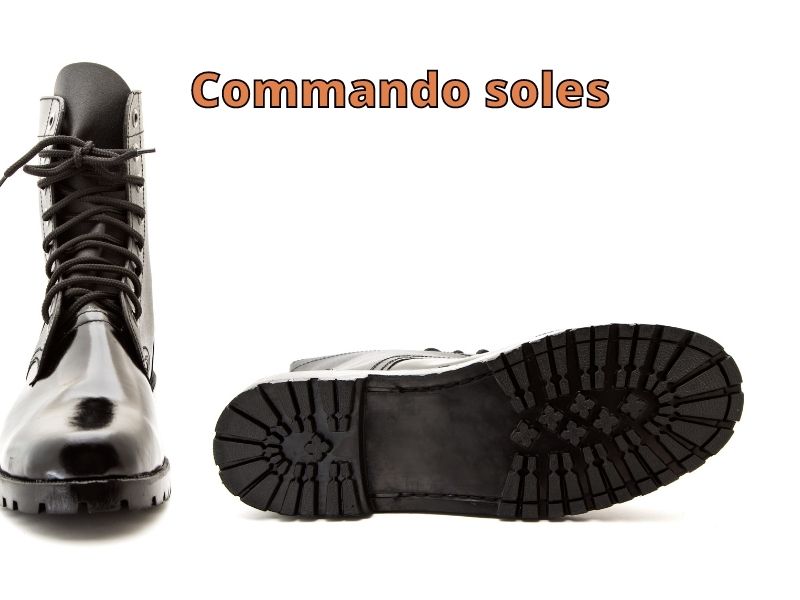A wide variety of shoe soles are out there in the market. Often it becomes difficult to choose the one that best suits your needs. Today I will discuss what are shoe soles, different types of shoe soles, their benefits, and what they are ideally used for.
The shoe sole is the outermost part of the shoe, also known as the outsole, is in direct contact with the ground. Shoe soles are made from different materials depending on the style and purpose of the shoe, such as rubber, leather, and other synthetic materials.
Here is a list of different types of shoe soles:
- Rubber Soles
- Leather Soles
- Vibram Soles
- Wedge Soles
- Crepe Soles
- Polyurethane Soles
- Polyvinyl Chloride PVC Soles
- Dainite Soles
- Cork Soles
- Commando Soles
The shoe soles are designed to be comfortable, durable, and long-lasting. The basic purpose of the shoe sole is to provide adequate traction and protection against the surfaces it will be in contact with. Do you have the right one? Let’s check out different soles and their benefits.
Different Types of Shoe Soles
Rubber Soles

Natural rubber has been used as a sole material for centuries. It is still a standard sole material available in the market. A shoe-marked RB means that your shoe sole is made with organic rubber or recycled rubber.
Rubber soles are ground and shortened to fit the surface. As a result, rubber soles give you excellent wear resistance and contraction stability that other sole materials do not offer.
I usually prefer rubber soles over others since they are cheaper and are quick to break in. Although these soles are affordable, they don’t compromise the look or feel of the shoe. But remember that rubber soles are often heavier than other sole materials.
Rubber soles are ideal for daily wear, but they suit various shoe styles. Therefore, you will find them on winter boots, hiking boots, casual everyday shoes, and even work boots. Rubber outsoles are also found on rain boots.
Benefits Of Rubber Sole
- Rubber soles are slip-resistant, so they provide you grip on slippery surfaces and prevent you from falling and slipping.
- Rubber soles are waterproof and oil-resistant so that you won’t need extra socks in wet conditions.
- These outsoles are resistant to acids, chemicals, and cement, therefore, protecting you from burns and hot temperatures.
- Another excellent quality of rubber soles is that they are bendable extremely durable.
- Rubber outsoles are waterproof and water-resistant so that you can wear them in any weather. There’s no need to worry about water getting into your shoes during a downpour.
Leather Soles

As their name implies, leather outsoles are made with leather. Rubber is added to the bottom to protect against water. However, leather soles may be a little less comfortable and slippery, so they can be mixed with rubber to increase their stability.
Leather soles have been famous for many years. Because of their elegant appearance, leather soles are associated with a luxurious look and feel. Therefore, they are usually found on formal shoes.
Although more expensive than other sole materials, leather is one of the best natural materials for shoe soles because it gives your shoes a better look.
Leather soles are more breathable than rubber soles, but you may find them stiff at first. However, the stiffness won’t last long, and you will soon find your shoes comfortable.
Benefits Of Leather Shoe Soles
- Leather shoe soles provide excellent traction, so you can wear them to walk up or down the hill.
- Leather soles are heavy-duty and long-lasting. If you properly maintain them, they can stand harsh conditions as well.
- Leather soles are more breathable, so your feet won’t sweat and remain cool and comfortable.
- A leather sole may be a better choice if you experience foot issues like sweat or foot odor.
- Leather soles are natural, sustainable, and are more durable.
- These soles are comfortable and easily adapt to your feet.
- Leather soles are elegant; they look stylish and hence an ideal option for formal shoes.
- They provide better support to your feet and prevent twisting.
- Leather shoe soles are more popular in summer since they are temperature resistant.
- Leather soles are easy to replace with plastic or rubber soles, so you will have a shoe that will have a long life.
Vibram Soles

Vibram soles are usually found on mountaineering boots, hiking shoes, and walking shoes. These soles are also more comfortable than others due to their textured rubber bottoms.
You can walk over different kinds of surfaces with Vibram shoe soles without having to worry about your feet slipping. Vibram soles are ideal for you if you walk longer distances, on wet terrains, or regularly go up and downhills. You can wear them in any weather and season.
Benefits Of Vibram Soles
- Vibram soles can be easily shaped to fit your feet.
- Vibram soles are slip-resistant, thus preventing you from falling and getting injured.
- These soles are durable and long-lasting. With proper care, they will last for years.
- Vibram soles are waterproof, so rain or puddles will not get in your way.
Wedge Soles

The spongy feel of wedge soles makes them popular. These soles have a wedge instead of a heel that gradually gets smaller.
Wedge soles are usually found on work boots and heritage-style boots. These shoe soles have great traction and are non-slip.
If you spend most of your time in the office and are looking for shoes that are easy to put on and take off, wedge shoe soles would be your best option. The only drawback, in my opinion, is that they can get damaged easily and aren’t much durable compared to other sole materials.
These soles are specially designed to provide more comfort and support to your feet by spreading out pressure over a larger surface area. As a result, they are ideal for workers who spend their entire day standing.
Benefits Of Wedge Soles
- Wedge soles are lightweight and offer excellent grip preventing you from slipping while walking uphill or downhill.
- Wedge soles a larger contact area with the ground to provide comfort and support.
- Shoes with wedge soles are easy to put on and take off.
Crepe Soles
Crepe soles are made from “crepe” rubber. Rubber and fabric are layered to create crepe soles. These soles are famous for their good-looking appearance. In addition, with increased midfoot protection, these soles provide a comfortable fit.
Crepe soles are perfect for modern boots. In addition, crepe soles are usually found on dress shoes, loafers, and casual footwear.
The only drawback I see with crepe soles is that they are heavy, and the material is open-pored, so it isn’t easy to clean them. Also, I won’t recommend crepe soles for winter or wet weather since they cannot provide enough traction.
Benefits Of Crepe Soles
- Crepe soles provide more grip than smooth soles so you can use them for regular walking around town.
- Crepe soles do not produce any sound, making them ideal for walking.
- Crepe soles enhance the look of shoes.
Polyurethane Soles

Organic polymer materials are used to make polyurethane soles. Polyurethane soles are extremely affordable, comfortable, and durable. These soles are usually found on safety shoes, jogging shoes, and walking shoes.
These soles are perfect for you if your job requires you to stand on your feet for long hours. Polyurethane soles also retain excellent mechanical properties for a long time.
Benefits Of Polyurethane Soles
- Polyurethane soles are more comfortable, durable, flexible, and lightweight.
- Polyurethane soles are waterproof.
- Polyurethane soles are famous for their superb shock absorption properties.
- Polyurethane soles are water-resistant, wear and tear-resistant, fat and oil resistant.
- Also, these soles provide decent slip resistance.
Polyvinyl Chloride PVC Soles
It might be surprising that you can have Polyvinyl Chloride in your shoe soles. PVC sole is famous for its insulation properties. The best thing about PVC soles is that they provide you with excellent insulation.
PVC soles are an affordable alternative and offer the same properties if you prefer leather soles. PVC soles can also be molded into various shapes, just like leather.
PVC soles are ideal for work shoes. These soles are usually found on dress shoes. Since PVC soles are low quality, they are heavy, rigid, and easily breakable. If you wear them for longer, your feet may feel uncomfortable.
Benefits Of PVC Soles
- PVC soles are made from recyclable materials, which makes them environmentally friendly.
- Polyvinyl chloride soles provide incredible insulation for your shoes.
- These soles are an affordable synthetic alternative to leather soles.
- PVC soles provide additional support and shock absorption.
Dainite Soles
Dainite soles have existed for centuries. But the slim design of Dainite soles makes them popular. Dainite soles are also a variation of rubber soles. These soles have a unique pattern marked by recessed lugs. Because of these lugs, stones and mud cannot stick to the soles.
Dainite soles are durable and comfortable. In addition, these soles are thin, giving them a low-profile appearance. Therefore, these soles are perfect for dress shoes.
Dainite soles are an elegant alternative to leather soles. While both feet are on the ground, a leather sole does not seem different from a Dainty sole. The only disadvantage I find in these soles is that they do not provide enough grip if you walk on mud terrain.
Benefits Of Dainite Soles
- Dainite soles can be used for prolonged wear.
- They provide excellent insulation, making them suitable for wearing in cold weather.
- Dainite soles provide a comfortable grip on wet and snowy surfaces.
- Just like leather soles, you can easily get your dainite soles replaced.
Cork Soles
Cork soles are made from a mixture of cork and rubber. Despite being lighter than rubber soles, cork soles are just as durable. I recommend cork soles if you like rubber soles but can’t stand their weight.
Cork soles are usually found on work boots. If your foot or joint hurts, I would recommend cork soles since they have great elasticity and possess natural strength
The only drawback I see with these soles is that they have no tread, so you can’t wear them in slippery conditions. But, otherwise, they are comfortable and perfect for everyday wear.
Benefits Of Cork Soles
- Cork soles are waterproof, odor-resistant, oil-resistant, and impact resistant.
- Cork soles provide a natural comfort level to your feet.
- Like leather, these soles conform to your foot and thus provide a custom fit.
- These soles offer great foot support.
Commando Soles

The last type of shoe sole I will be discussing is commando soles.
Commando soles are mostly famous for their weather resistance properties. You can wear them in any weather because of their thick lugs and rugged profile. Protruding lugs make them unique from any other sole since they provide unmatched traction.
Commando soles are ideal for hiking boots and work shoes. These shoe soles have excellent traction and grip.
You will see commando soles on two different shoes, either hiking boots or work shoes. In addition, you can have commando soles in your casual shoes and even dress shoes.
Shoes with these types of soles tend to be chunkier than others since the soles are thick and heavy. Therefore, if you prefer light shoes, you better skip these soles.
I find these shoe soles heavier and chunkier than other soles, but they are ideal for resisting elements. Unfortunately, these soles tend to crack, stiff, or break down over time, so they aren’t long-lasting. Also, Commando soles can easily attract mud, rocks, grass, so you need to clean them after every use.
Benefits Of Commando Soles
- You can wear commando soles in any season.
- Commando soles are perfect for you if you regularly walk long distances or use public transport everywhere.
- These soles are textured, which makes them more comfortable than others.
- These soles offer excellent traction, so you can walk over different surfaces without your feet slipping.
- Commando soles will keep your feet warm even in freezing temperatures.
- These soles are comfortable, so you can walk for hours without feeling tired.
In order to find the best sole for your needs, take a look at this chart. There are so many shoes made for specific purposes, using the correct sole on a shoe helps the shoe function like supposed to.
| Types Of Shoe Soles | The Soles Are Ideal For |
|---|---|
| Rubber Soles | Winter boots, hiking boots, casual everyday shoes, work boots, rain boots. |
| Leather Soles | Formal shoes |
| Vibram Soles | Mountaineering boots, hiking shoes, and walking shoes. |
| Wedge Soles | Work boots and heritage-style boots. |
| Crepe Soles | Dress shoes, loafers, and casual footwear. |
| Polyurethane Soles | Safety shoes, jogging shoes, and walking shoes. |
| Polyvinyl Chloride PVC Soles | Dress shoes |
| Dainite Soles | Dress shoes |
| Cork Soles | Workboots |
| Commando Soles | Hiking boots and work shoes. |
Thanks for visiting helpshoe.com
References

![What Are Shoe Soles_ [Different Types Explained]](https://helpshoe.com/wp-content/uploads/2022/02/What-Are-Shoe-Soles_-Different-Types-Explained.jpg)